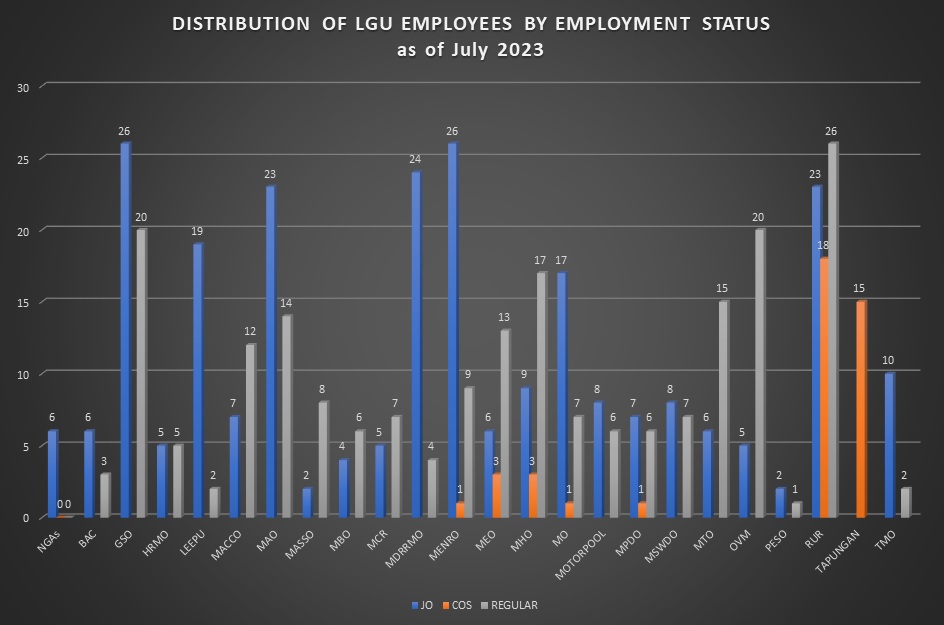Municipal Distribution of Employees by Gender

The importance and benefits of municipal human resource distribution of employees by gender are significant in promoting gender equality and achieving a balanced and inclusive workforce. Here are some key reasons why it is important and beneficial to distribute employees by gender in local government unit.
1. Gender Equality: Municipalities have a responsibility to ensure equal opportunities for all individuals, regardless of their gender. By actively distributing employees by gender, municipal organizations can strive for a better gender balance across various departments and positions. This promotes fairness and equal representation, allowing both men and women to contribute and thrive in the workplace.
2. Diverse Perspectives: Having a gender-balanced workforce brings diverse perspectives and experiences to decision-making processes. Men and women often have different viewpoints, problem-solving approaches, and communication styles. By having a mix of perspectives, municipal organizations can make more informed and inclusive decisions that consider a wider range of viewpoints and benefit the entire community.
3. Increased Innovation and Creativity: Research has shown that diverse teams are more innovative and creative. When employees with different backgrounds and experiences collaborate, they bring unique ideas, insights, and solutions to the table. By ensuring a diverse gender workforce, municipal organizations can tap into this creativity and innovation, leading to improved services, programs, and policies for the community.
4. Enhanced Performance and Productivity: Gender-diverse teams tend to perform better and achieve higher levels of productivity. When individuals feel that their perspectives and contributions are valued, they are more likely to be engaged and motivated. By distributing employees by gender, municipal organizations can create an inclusive and supportive work environment, improving job satisfaction and overall performance.
5. Improved Community Engagement: A gender-balanced workforce in municipal organizations helps establish trust and credibility with the community. When residents see a diverse representation of individuals in positions of authority, they are more likely to perceive the organization as inclusive, responsive, and trustworthy. This leads to increased community engagement, participation, and collaboration in municipal initiatives and decision-making processes.
6. Role Modeling and Career Advancement: Gender-balanced distribution of employees also serves as a role model for the community, especially for young individuals. When they see women and men in diverse roles and positions within municipal organizations, they are encouraged to pursue careers in traditionally underrepresented fields. This promotes gender equality beyond the organization and contributes to breaking down societal gender stereotypes.
Distributing employees by gender in municipal organizations is not only important for promoting gender equality, but it also brings numerous benefits, including diverse perspectives, increased innovation, enhanced performance, improved community engagement, and role modeling for future generations. By prioritizing and investing in gender diversity, municipalities can create more inclusive and equitable workplaces that positively impact the community as a whole.
Distribution of LGU Employees by Employment Status

The graph presents the distribution of employees in different departments of a Local Government Unit (LGU) based on their employment status. The employment status is divided into three categories: Contract of Service and Job Order and Regular Employees.
The x-axis of the graph represents the different departments within the LGU. The y-axis represents the number of employees in each category.
The first category, Contract of Service, refers to employees who are hired on a contractual basis and have a formal employment agreement with the LGU. These employees may have fixed-term contracts and are entitled to certain benefits and protections under the labor laws.
The second category, Job Order, refers to employees who are engaged on a project-based or temporary basis. They are usually hired to perform specific tasks or provide services for a limited period. Job Order employees may not have the same level of job security, benefits, or labor protections as Contract of Service employees.
The graph is used to evaluate the LGU’s workforce management strategies and policies. For instance, if a particular department heavily relies on Job Order employees, it may indicate a need to review recruitment and retention practices. It could also highlight the need for more permanent positions or better job security for employees in certain areas.
Furthermore, the graph provides an overview of the LGU’s commitment to promoting inclusive employment practices. It allows Human Resource department to assess whether Contract of Service positions are being adequately utilized and whether there is room for improvement in terms of offering secure employment opportunities.
Analyzing the graph of municipal distribution of LGU employees by employment status can offer valuable insights into workforce composition, management practices, and areas for potential improvement in promoting fair and secure employment within the municipality.

